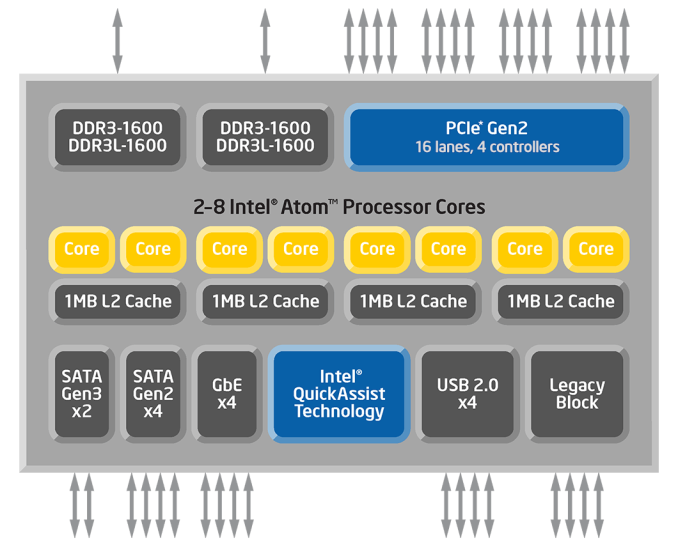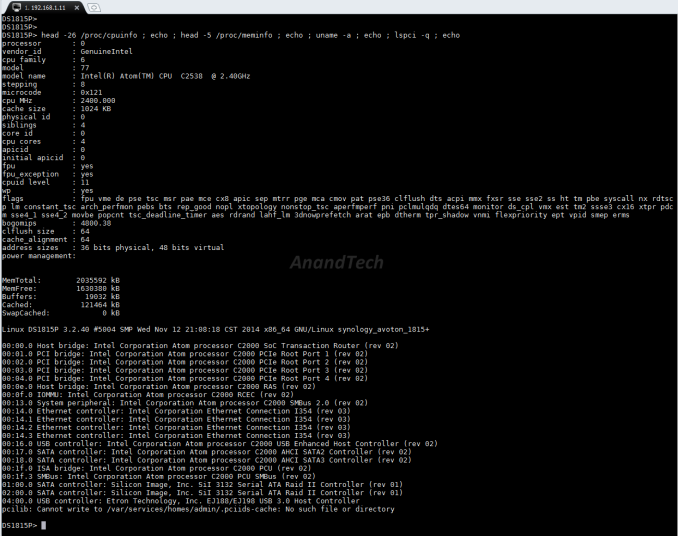Synology DS1815+ 8-bay Intel Rangeley SMB NAS Review
by Ganesh T S on November 18, 2014 6:30 AM ESTPlatform Analysis
The higher end segment of the SOHO / SMB NAS market uses Intel's Core-series and Xeon CPUs to deliver the required performance while supporting a large number of drive bays (typically more than 8, in a rackmount form-factor). Over the last four years or so, Intel's play in the other tiers has been mainly with its Atom CPU lineup. Back in 2010, Intel pushed the 45 nm Atom D410 / D510 / D525 for NAS units. In 2012, it was the 32 nm Atoms, the D2550 and D2700. All of these were based on the in-order Bonnell microarchitecture which was fast becoming dated compared to the advancements being made by the ARM SoC vendors. In moving from 32nm to 22nm, Intel completely revamped the microarchitecture for their Atom cores. Bonnell was replaced by Silvermont, bringing out of order execution and other improvements into the picture. Silvermont's applicability to a variety of power profiles meant that there were multiple product lines that ended up using the CPU cores. Bay Trail is proving very effective in tablets and also makes up QNAP's TS-x51 and TS-x53 Pro NAS series. Merrifield and Moorefield are trying to break into smartphones, but it is Avoton and Rangeley that are more relevant to the storage appliances market.
The different product lines integrate different I/O around the Silvermont cores depending on the target market. Avoton is meant for microservers and cloud storage platforms, while Rangeley is meant for communication and network infrastructure. Both of them integrate similar I/O around the cores, but the Rangeley parts have an updated crypto engine. The block diagram of a generic Rangeley part is provided below.
There is a wealth of I/O (2x SATA Gen 3, 4x SATA Gen 2 and up to 16 PCIe 2.0 lanes) for the storage subsystem, and the parts also support up to 4x 2.5 Gbps network links. From the viewpoint of the Synology DS1815+, the above block diagram should be considered in the context of the information gleaned via SSH access to the unit.
The DS1815+ uses the Intel Atom C2538 SoC which has four Silvermont cores running at 2.4 GHz. It is backed up by 2 GB of DRAM. The Atom C2538 has 16 PCIe 2.0 lanes. The Silicon Image SiI3132 PCIe to 2-port SATA II host controller uses a single PCIe 2.0 lane on the host side. There are two of them using up two PCIe 2.0 lanes in total. Unlike the DS415+ in which the USB 3.0 ports were provided by the Etron EJ168 USB 3.0 host controller, the DS1815+ uses the Etron EJ198. This USB 3.0 host controller uses two PCIe lanes to enable the four USB 3.0 ports found on the rear side of the unit. The four Ethernet controllers are all based on the Intel I354. Despite being 2.5G-capable, the transceivers they are connected to make them GbE ports.
The more interesting hardware aspect is the absence of any PCIe to SATA bridges for the internal ports. Given that the C2538 has only a total of six SATA ports (2x SATA III and 4x SATA II) and there are no bridges in the SSH report, it can be inferred that a port multipler (1x SATA host to 2x SATA device) such as the ASMedia ASM1092 must be in use. However, without opening up the unit (which we haven't done yet, given our limited time to bring out the review), this can't be confirmed.
On the software front, the DS1815+ runs Linux (kernel version 3.2.40). We have covered DSM 5.0's setup and usage impressions in our recent DS214play and DS414j reviews. There is not much point in rehashing the same excellent setup and usage experience. That said, with the ioSafe 1513+, we also started looking at iSCSI support in NAS units. We will be looking at that aspect in this review also.












65 Comments
View All Comments
vLsL2VnDmWjoTByaVLxb - Tuesday, November 18, 2014 - link
Sorry, that was meant as a response for JeffFlanagan's post above. :\JustaUsernameorWE - Tuesday, November 18, 2014 - link
Anyone have any idea when/if they'll put Rangeley in a 2bay unit? Not thrilled with the current 2 bay market.ganeshts - Tuesday, November 18, 2014 - link
Synology doesn't have one (yet), but the Seagate NAS Pro 2-bay should fit your needshttp://www.seagate.com/products/network-attached-s...
It is based on Rangeley too, albeit a 2C/2T model running at 1.7 GHz.
romrunning - Tuesday, November 18, 2014 - link
Is there any specs on how these perform when compare to a simple, business-class server that has 8-bays? Something like a Dell PowerEdge T320 that has the capability for 8 x 3.5" drives and includes a quad-port GB NIC can be had for basically the same price as the Synology here.These larger-cost 8-bay NAS machines have a high price tag, so a natural competitor (in terms of price) seems to be servers from the standard server vendors. So I would love to see how it actually compares.
peterfares - Tuesday, November 18, 2014 - link
Poorly. Their only advantages over a computer are smaller and more power efficient. People will talk about how it saves so much time but you have to save quite a lot of time to make up the difference in cost between a synology and a much cheaper and faster computer.romrunning - Wednesday, November 19, 2014 - link
I also would like to know if some of the poor network performance numbers shown by these selected NAS units are also present in a full server setup.I guess we'll never know because these review units likely come with caveats on what type of "competing" devices they can reviewed against.
dgingeri - Tuesday, November 18, 2014 - link
An Atom processor, 8 bays, 2GB of memory, and 8 bays, for $1050. I could build better for less, and get more flexibility.peterfares - Tuesday, November 18, 2014 - link
BUT YOU CAN SAVE SO MUCH TIME WITH A SYNOLOGY!!!!!Haha. Those peoples time must be worth a lot. And if it's worth that much, why are they going for a Synology and not something better?
rpg1966 - Tuesday, November 18, 2014 - link
:rolleyes:DiHydro - Wednesday, November 19, 2014 - link
My time, plus any employees or services I have on the NAS could cost me the initial price each *hour* if it goes down. So having one physical unit, with hot swap, and on the fly rebuild is worth the price in some cases.